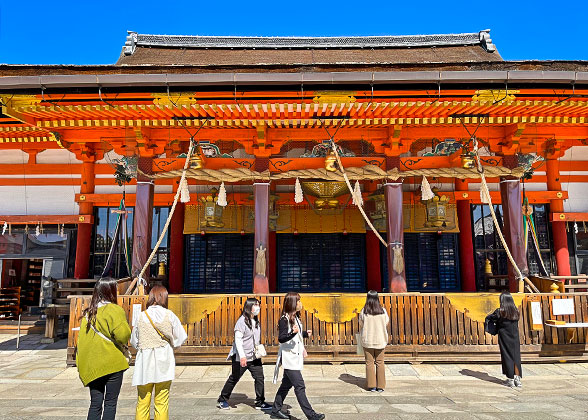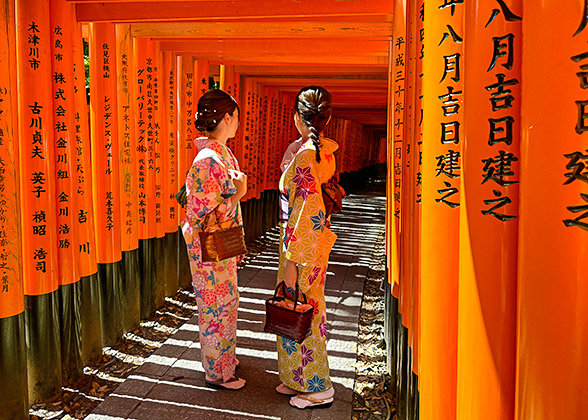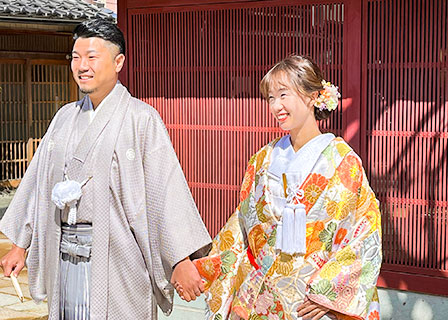Yasaka Shrine
Japan has more than 3,000-plus Yasaka Shrines, but the head one sits in the ancient capital of Kyoto (we will refer to the head shrine simply as Yasaka Shrine hereafter), at the eastern Gion district. Japanese people affectionately call it Gion Shrine, as it was where originated Gion Matsuri, or Gion Festival, one of the three Great Festivals held in Japan, the other two being Osaka’s Tenji Masturi and Tokyo’s Kanda Festival. The primary deity enshrined here is Susanoo-no-mikoto, the Shinto god of sea that dispels evil forces. Yasaka Shrine dates back to as early as 656 AD.

Yasaka Shrine Photos ( 17
|
Story of the Enshrined Deity
As the god of sea, Susanoo-no-mikoto was originally dwelling in Takama-ga-hara, the heaven of Shinto religion, as were other Japanese gods. One day, for the defiant neglect of duty, he was expelled to the mortal world. There, in Izumo, an eight-headed serpent was doing evil, forcing people to make human sacrifices. Susanoo-no-mikoto just came down the right time when a girl named Kushiinadahime was to be offered. After taking down the monster and saving her life, Susanoo and girl fell in love and got married.For his heroic deeds to eliminate the sinister, Susanoo-no-mikoto is the most venerated gods for Japanese people. And Yasaka Shrine, because of the god, became the most loved and visited by locals who wish to avert evil and ill-fortune. His wife, Kushiinadahime-no-mikoto, in charge of marriage and happiness, was also enshrined.
Gion Matsuri (Gion Festival):
Speaking of Yasaka Shrine, the first thing that occurs to mind is its Gion Matsuri (Gion Festival). Its history can be traced back to 869 AD, when a plague swept Kyoto and caused numerous deaths. At that time, people thought it as a consequence of some malice of evil spirits. To get rid of them, 66 provinces were requested to carry Mikoshi (portable shrine) of deities, from their Yasaka Shrine branches, to Shinsen-en Garden in the west of Kyoto to bestow blessings. Hence the tradition of Gion Matsuri.When to attend and what to expect during Gion Matsuri?
The festival lasts for an entire month of July, but the most spectacular parts fall on July 17th and 24thYou May Like
Other recommended festivals at Yasaka Shrine:
February 2nd: Setsubun-sai (afternoon). People throw beans to dispel evil spirits. Geisha dances can be expected on the dance stage before Honden, the main hall.
December 31st: Joya-sai (after 7:00 pm). Lanterns lit with the sacred fire in the shrine are carried home by Japanese people, its flames used for prayer.
Highlights at Yasaka Shrine
Visit Honden, the main hall
To be precise, Haiden and Honden together make up the main hall. Connecting with each other under a single roof, Haiden is the place of offering and Honden the actual sanctuary where Susanoo-no-mikoto and his wife Kushiinadahime-no-mikoto are enshrined. Before telling your wishes to the gods, remember to ring the bell at the front by pulling the cord it tethers to – a ritual to let gods notice you.

Hoden and the front Dance Hall
|
Before the main hall also stands a dance hall, a roofed stage used for religious performances. It’s particularly charming when its rows of hanging lanterns are lit after 18:00.
|
|
|
Visit main subsidiary shrines
 Utsukushi Gozen Sya, the shrine dedicated to beauty
Utsukushi Gozen Sya, the shrine dedicated to beauty

Girl praying to the goddess of beauty
|
 Hamono jinjya, enshrining the god of blades that severs bad relationships
Hamono jinjya, enshrining the god of blades that severs bad relationships
Legend has it that the shrine, dedicated to the Shinto god of blades, is where knives originated. Here, visitors can wish for an end to torturing relationships and forging good ones.
 Eki Jinjya, the shrine to pray for peace and health
Eki Jinjya, the shrine to pray for peace and health
Somin Shorai is the enshrined deity. Once a mortal, Somin Shorai had provided shelter for Susanoo-no-mikoto who disguised himself as a traveler. For his kind heart, Somin Shorai and his family were all blessed and thus survived a plague that killed those who had refused to help the god. As his name equals to peace and blessings, there is even a talisman reading “the descendants of Somin Shorai” and which people can receive on festivals.
 Ohokuni Nushi Sya, blessing people with happy love relationship
Ohokuni Nushi Sya, blessing people with happy love relationship
Seeking an ideal partner? Come here and pray to Okuninushi-no-mikoto, the deity of good matches. Okuninushi was at first a man seeking marriage with a princess. He saved a skinned rabbit on his way, and this rabbit, who was actually a god, thanked him by granting his wish. To learn this story is to understand why the shrine is also associated with rabbit.
|
|
|
Pass different gates to other landmarks
Passing West Gate, the iconic main entrance, to enter Yasaka Shrine and stepping out from other gates would be a wise choice. The Southeast Gate leads to Maruyama Park, the perfect place for cherry blossom viewing in spring; the South Gate opens to a lane called “Nene no Michi”, an approach to Sanneizaka, an ancient shopping street lined with traditional wooden buildings leading to Kiyomizu-dera Temple, the most celebrated temple in Kyoto.

The South Gate, or Minami-romon Gate
|
Good to Know
Light-up time: 18:00 pmAdmission fee: Free
Opening hours: Open all year around
How to Get There?
By bus:Take No. 206 or No. 207 from Kyoto Station and get off at Gion bus stop.
By train:
Take Keihan Line, get off at Gion Shijo Station, and walk 5 minutes;
Take Hankyu Line, get off at Kawaramachi Station, and walk less than 10 minutes.
Nearby Don’t-Miss Atttrations
It’s Gion Festival that gives the name of “Gion” to the busy area before Yasaka Shrine. Geisha, a female profession performing art for high social classes, originated here 300 years ago and are still seen working here in old teahouses. Besides encountering geisha, people also come here to feel thick historical vibe and sample haute Japanese cuisine.
With over 680 cherry trees, Maruyama Park is Kyoto’s best place to experience Hanami Festival during springtime, when locals would gather under pink seas of blossoms eating and chatting.
Walk through the ancient Ninenzaka and Sannenzaka streets to the south and you will arrive before the 1,200-year- old Kiyomizu-dera Temple. People love to overlook the cityscape of Kyoto from the veranda of its main hall, which was always praised as an engineering feat erected without using a single nail.
Kyoto City Zoo is a great place to check out if you are taking kids with you. It’s the second oldest zoo in Japan and a member of WAZA (World Association of Zoos and Aquariums), dedicated to conserving diversity of animals.
![]() Kamo River (700 meters/0.4 miles away to the west, 10 minutes walk)
Kamo River (700 meters/0.4 miles away to the west, 10 minutes walk)
Kamo River is a 31-km-long river flowing through Kyoto, with beautiful scenery and traditional Japanese buildings by the riverside.
![]() Pontocho (850 meters/0.53 miles away to the west, 12 minutes walk)
Pontocho (850 meters/0.53 miles away to the west, 12 minutes walk)
Pontocho is a historical street with many traditional restaurants and pubs. It's one of the best places to experience geisha culture in Kyoto.
Yasaka Shrine Photos & more Kyoto Photos





